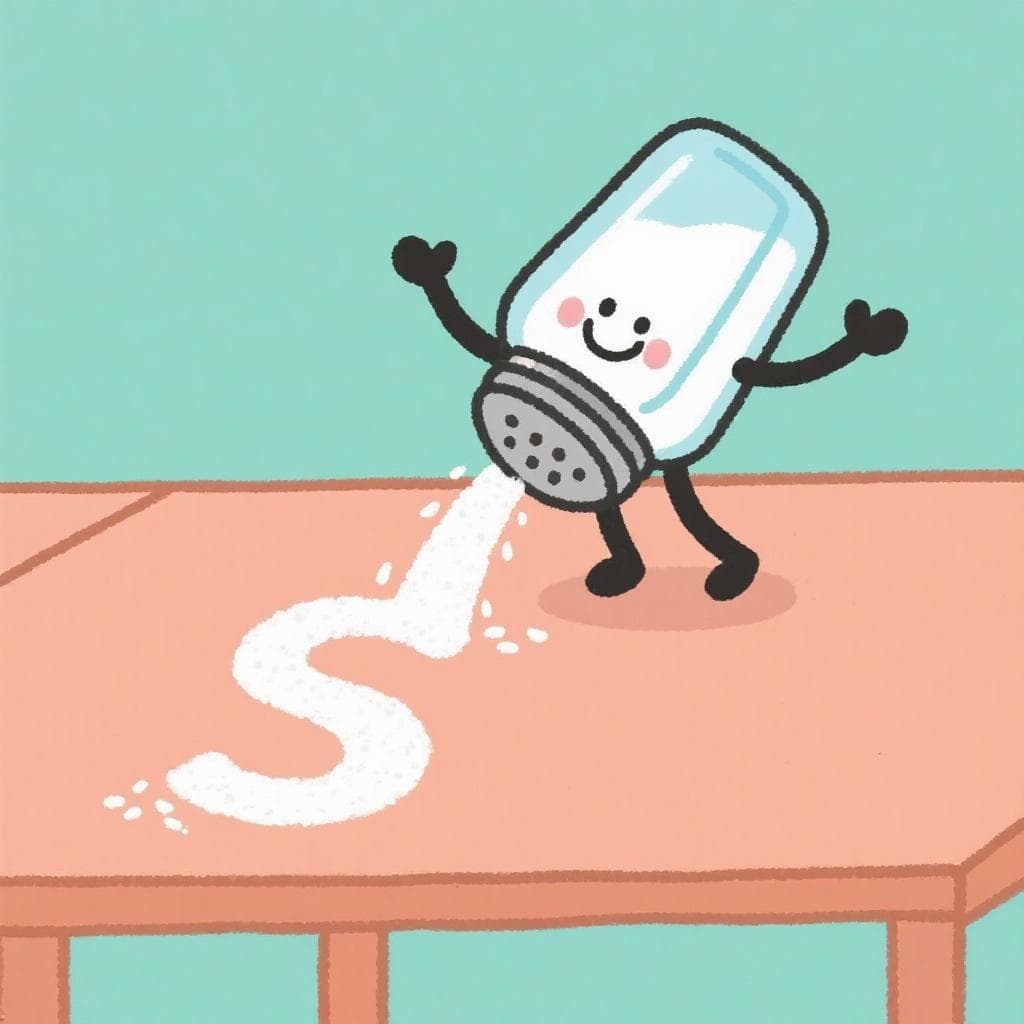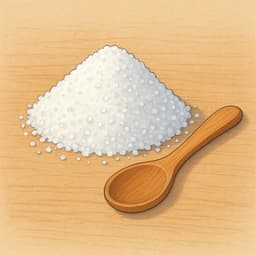La sal del salero sale sola.
la SAL del sa-LE-ro SA-le SO-la
The salt from the salt shaker comes out by itself.
🔊 Listen & Practice
Start with slow speed to master pronunciation, then gradually increase to challenge yourself.
🎨 Visualization

The salt is spilling all by itself! This one is all about the 's' and 'l' sounds.
🎯 Pronunciation Focus
The Crisp Spanish 's'
/s/This sound is sharper and cleaner than the English 's'. Your tongue should be close to your top teeth, and the sound should be a hiss, like air escaping from a tire. It's always voiceless, like the 's' in 'snake', never buzzy like the 'z' in 'zoo'.
The Light Spanish 'l'
/l/Unlike the English 'l' (which can be 'dark' and made in the back of the throat, like in 'full'), the Spanish 'l' is always 'light'. To make it, touch the tip of your tongue to the ridge right behind your top front teeth. It's a bright, clear sound.
📝 Practice Breakdown
Let's start here. Focus on making a clear, 'light L' sound. The tip of your tongue should tap right behind your top front teeth for 'la', 'del', and 'salero'. Don't let the sound get 'stuck' in the back of your throat.
Now for the 's' sounds. Keep them crisp and hissy. Notice how your tongue moves from the 's' position to the 'l' position in 'sale' and 'sola'. It's a quick forward-and-back motion.
Time to combine them! The real workout is switching between the 's' and 'l' sounds. Try to say it slowly at first, feeling the difference in your tongue position for each sound, then gradually speed up.
Key Words in This Tongue Twister:
📚 Background
This is a classic, simple 'trabalenguas' that Spanish speakers often learn as children. Its purpose isn't to be confusing with complex words, but to train the mouth to move quickly and precisely between the very common 's' and 'l' sounds.
❌ Common Pitfalls
Using the English 'Dark L'
Mistake: "Pronouncing the 'l' in 'sal' or 'sola' from the back of your throat, like the 'l' in the English word 'full'. This can make the words sound heavy or muffled."
Correction: Always bring your tongue forward! For every 'l' in Spanish, the tip of your tongue should make clear contact with the roof of your mouth right behind your top teeth. Think of the 'l' in 'light' or 'lemon' – it's always that bright sound.
A 'Buzzy' or 'Lazy' S
Mistake: "Letting the 's' sound become a 'z' sound, like 'roze' instead of 'rose'. This is common in English but almost never happens in most Spanish dialects."
Correction: Keep the air flowing and don't use your vocal cords for the 's'. It should always be a sharp hiss, like the sound of a snake. Practice by saying 'ssssss' and then adding the vowels: 'sa', 'se', 'si', 'so', 'su'.
🌎 Where It's Used
General Spanish
This tongue twister is universally known and used across the entire Spanish-speaking world as a basic pronunciation exercise.
🔗 Related Tongue Twisters
The Slippery Salt Challenge
Can you say it five times in a row, getting faster each time, without your 's' and 'l' sounds getting mixed up? Try to do it in under 7 seconds!
🏷️ Tags
Frequently Asked Questions
Is 'sale sola' a phrase people actually use?
Yes, absolutely! Unlike many tongue twisters, this one ends with a very common and useful phrase. 'Sale solo/a' means 'it comes off by itself' or 'it comes out on its own'. You might say 'La mancha sale sola con agua' (The stain comes out on its own with water).
Why is it so hard to switch between 's' and 'l' quickly?
Because it requires a very precise and rapid movement of your tongue. For 's', your tongue is close to the roof of your mouth without touching, letting air hiss through. For 'l', your tongue tip firmly taps that same spot. Doing this back-and-forth quickly is like a workout for your tongue muscles!


